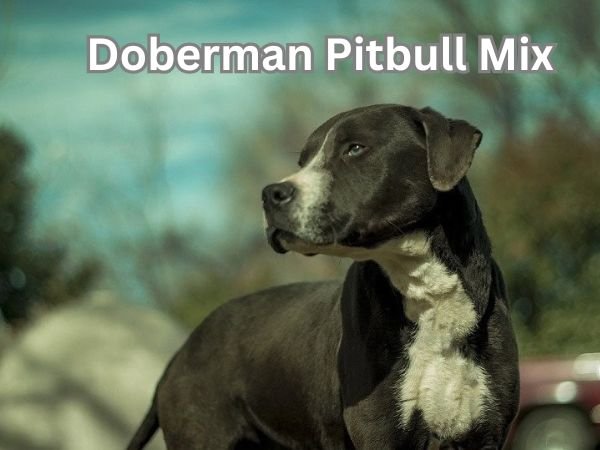
When people hear the term Doberman Pitbull Mix, two ideas often come to mind:
First, the unique and striking appearance of this hybrid, sometimes called the “Doberpit” or “Pit Pinscher,” which blends the sleek strength of the Doberman with the muscular energy of the Pitbull.
Second, questions about what to expect from a mixed breed dog that combines traits from two powerful parents—especially regarding health, temperament, and lifespan.
In this article, we’ll dive into everything you need to know about the Doberman Pitbull Mix—from common myths to real health concerns, including Doberman Pit health issues and the typical Doberpit lifespan. While mixed breeds often benefit from hybrid vigor, it’s still important to understand potential health risks and how to provide the best care. Whether you’re considering adopting or already own one of these energetic dogs, this guide offers expert insights and practical advice to help you make informed decisions and enjoy a happy, healthy relationship with your Doberpit.
What Is a Doberman Pitbull Mix?
A Doberman Pitbull Mix is a dog that has one Doberman parent and one Pitbull parent. People also call this mix a “Doberpit” or “Pitman.” These dogs are not a pure breed. They are a mix, or a “designer breed,” made by crossing two different breeds.
Background on Parent Breeds
Doberman Pinscher
- Dobermans are strong, smart, and loyal dogs.
- They were first bred in Germany to help guard people and homes.
- Dobermans are known for their sleek black and tan coats.
- They are often used as police or guard dogs.
American Pit Bull Terrier
- Pitbulls are muscular and energetic dogs.
- They were first bred in the United States and England.
- Pitbulls are known for their wide heads and strong jaws.
- They are friendly with people but need good training.
How Doberman Pitbull Mixes Can Look
- These dogs can look different from each other, even in the same litter.
- Some have the longer face of a Doberman, while others have the wide head of a Pitbull.
- Their ears can stand up or flop down.
- Their coat is usually short and shiny.
- Colors can be black, brown, gray, or a mix.
Temperament and Personality
- They are often loyal and loving with their families.
- They can be protective and may bark at strangers.
- Some are gentle and calm, while others are more active and playful.
- They are smart and learn quickly.
- They need good training and social time with people and other pets.
Energy and Exercise Needs
- These dogs have a lot of energy.
- They need daily walks and playtime.
- They enjoy running, playing fetch, and learning new tricks.
- Without enough exercise, they can get bored and chew things.
Hybrid Vigor and Designer Breed
- “Hybrid vigor” means mixed-breed dogs can be healthier than purebreds. They may have fewer health problems.
- Designer breeds are mixes made on purpose, like the Doberman Pitbull Mix.
- People like these mixes because they hope to get the best traits from both parent breeds.
A Doberman Pitbull Mix is a strong, smart, and loving dog. They can look and act in many different ways. These dogs need lots of exercise, good training, and love from their families. With the right care, they can be great pets.
Why Health Screening Matters for Doberpits
A Doberman Pitbull mix, often called a Doberpit, is a strong and loving dog. But, like all mixed breeds, they can get health problems from both parents. Health screening is very important for Doberpits. It helps keep them happy and healthy.
Inherited Genetic Conditions
Doberpits can inherit health issues from both Dobermans and Pit Bulls. Knowing about these problems helps you care for your dog better.
Common Health Issues from Dobermans
- Heart problems: Dobermans often get a heart disease called dilated cardiomyopathy. This makes the heart weak.
- Blood issues: Some Dobermans have a bleeding problem called von Willebrand’s disease.
- Hip problems: Hip dysplasia is when the hip joint does not fit right. It can cause pain and trouble walking.
Common Health Issues from Pit Bulls
- Skin allergies: Pit Bulls often have itchy skin or allergies.
- Thyroid problems: Some Pit Bulls have trouble with their thyroid, which controls energy.
- Knee problems: Pit Bulls can have knee injuries, like torn ligaments.
Why Regular Vet Checkups Matter
Taking your Doberpit to the vet often is very important.
- Vets can find problems early, before they get worse.
- Regular checkups help track your dog’s weight, teeth, and general health.
- Vaccines and flea medicine keep your dog safe from sickness and bugs.
The Importance of Genetic Testing
Genetic testing means checking your dog’s DNA for health problems. This is very helpful for Doberpit owners.
- It can show if your dog might get certain diseases.
- You can make better choices about food, exercise, and care.
- You can plan for any special needs your dog might have.
Key Points for Doberman Pitbull Mix Health Screening
- Health screening helps find problems early.
- Doberpits can get heart, hip, skin, and thyroid problems.
- Regular vet visits are important for Doberpit vet care.
- Genetic testing gives you more information to keep your dog healthy.
Simple Tips to Keep Your Doberpit Healthy
- Take your Doberpit to the vet at least once a year.
- Ask your vet about genetic testing for your dog.
- Watch for signs of pain, itching, or tiredness.
- Feed your dog good food and make sure they get enough exercise.
Health screening for your Doberman Pitbull mix is the best way to help them live a long, happy life. Regular vet care and genetic testing are smart steps for every Doberpit owner.
Doberman Pitbull Mix: Top 6 Health Concerns to Watch For 🩺
Doberman Pitbull mixes, also called Doberpits, are strong and loving dogs. But, like all breeds, they can have some health problems. Here are the top six health concerns you should know about.
1. Heart Disease (Dilated Cardiomyopathy & Aortic Stenosis)
What it is:
- Dilated Cardiomyopathy (DCM) means the heart muscle gets weak and stretched. The heart cannot pump blood well.
- Aortic Stenosis is when a heart valve is too narrow, making the heart work harder.
Why Doberpits are prone:
- Dobermans often get DCM.
- Both Dobermans and Pitbulls can pass down heart problems like aortic stenosis.
Signs to watch (symptoms):
- Gets tired easily
- Coughing
- Breathing fast or hard
- Fainting or collapsing
- Swollen belly
Prevention & management:
- Take your dog to the vet for heart check-ups.
- Watch for early signs and act quickly.
- Keep your dog at a healthy weight.
- Follow your vet’s advice for medicine and care.
2. von Willebrand’s Disease (Bleeding Disorder)
What it is:
- This is a blood clotting problem. It means your dog can bleed for a long time after a cut or injury.
Why Doberpits are prone:
- Dobermans often carry this disease. Doberpits can inherit it.
Signs to watch (symptoms):
- Nosebleeds
- Bleeding gums
- Bruising easily
- Bleeding a lot after small cuts
Prevention & management:
- Ask your vet about genetic testing.
- Be careful with surgeries or injuries.
- Tell your vet if your dog has this problem before any operation.
3. Joint & Orthopedic Issues (Hip Dysplasia, Cruciate Ligament Injury, Wobblers Syndrome)
What it is:
- Hip Dysplasia: The hip joint does not fit right, causing pain and trouble walking.
- Cruciate Ligament Injury: A knee ligament tears, making it hard to walk.
- Wobblers Syndrome: A neck problem that causes a wobbly walk.
Why Doberpits are prone:
- Both parents can have hip problems.
- Dobermans can get Wobblers Syndrome.
- Big, active dogs can hurt their knees.
Signs to watch (symptoms):
- Limping
- Stiffness
- Trouble standing up
- Wobbly walk
- Pain when moving
Prevention & management:
- Keep your dog at a healthy weight.
- Avoid too much jumping or rough play.
- Give joint supplements if your vet says so.
- Go to the vet if you see limping or pain.
4. Gastric Torsion (Bloat)
What it is:
- The stomach fills with gas and twists. This is very serious and can be deadly if not treated fast.
Why Doberpits are prone:
- Large, deep-chested dogs like Doberpits are at higher risk.
Signs to watch (symptoms):
- Swollen, hard belly
- Trying to vomit but nothing comes out
- Drooling a lot
- Restlessness or pain
- Fast breathing
Prevention & management:
- Feed smaller meals, not one big meal.
- Don’t let your dog run or play right after eating.
- Go to the vet right away if you see signs of bloat.
5. Osteosarcoma & Hypothyroidism
What it is:
- Osteosarcoma: A type of bone cancer.
- Hypothyroidism: The thyroid gland does not make enough hormones, slowing the body down.
Why Doberpits are prone:
- Big dogs like Dobermans and Pitbulls can get bone cancer.
- Dobermans can also have thyroid problems.
Signs to watch (symptoms):
- For bone cancer: Swelling on legs, limping, pain
- For hypothyroidism: Weight gain, tiredness, dry skin, hair loss
Prevention & management:
- Watch for lumps, swelling, or limping.
- See your vet if you notice changes.
- Thyroid problems can be managed with daily medicine.
6. Skin Sensitivities, Ear Infections & Allergies
What it is:
- Skin problems, itchy skin, and ear infections.
Why Doberpits are prone:
- Both Dobermans and Pitbulls can have sensitive skin and allergies.
Signs to watch (symptoms):
- Itchy, red, or flaky skin
- Licking or scratching a lot
- Ear redness, smell, or discharge
Prevention & management:
- Bathe with gentle dog shampoo.
- Clean ears regularly.
- Feed a healthy diet and ask your vet about allergy foods if needed.
Strategies for Prevention & Early Detection in Doberman Pitbull Mixes
Doberman Pitbull mixes, or Doberpits, are active and loving dogs. Keeping them healthy takes some planning. Here are simple ways to help prevent problems and catch health issues early.
1. Recommended Vet Screenings
Regular vet visits help find problems before they get serious. Ask your vet about these tests:
- Echocardiogram:
Checks the heart for problems like weak muscles or narrow valves. - Blood Clotting Tests (vWD):
Looks for bleeding disorders that are common in Dobermans. - X-rays for Hips:
Finds hip problems early, like hip dysplasia. - Thyroid Panel:
Check if the thyroid gland is working right. - GI (Stomach) and Ear Exam:
Finds stomach issues and ear infections.
Tip:
Schedule these tests every year or as your vet suggests.
2. Diet & Exercise Tips for High-Energy Dogs
Doberpits have lots of energy. They need good food and plenty of play.
Diet Tips
- Feed high-quality dog food with real meat as the first ingredient.
- Give the right amount for your dog’s size and age.
- Split food into two or three small meals a day to help prevent bloat.
- Avoid giving table scraps or fatty foods.
Exercise Tips
- Give at least one hour of active play or walks every day.
- Play games like fetch or tug-of-war.
- Try activities like running, hiking, or agility training.
- Change up activities to keep your dog interested.
Tip:
A tired Doberpit is a happy Doberpit!
3. Grooming Routine to Prevent Skin and Ear Issues
Good grooming keeps your Doberpit’s skin and ears healthy.
Skin Care
- Brush your dog once or twice a week to remove loose hair and dirt.
- Use a gentle dog shampoo for baths, about once a month or when dirty.
- Check for red spots, bumps, or dry skin.
Ear Care
- Look inside your dog’s ears every week.
- Wipe ears gently with a soft cloth or vet-recommended ear cleaner.
- Watch for redness, bad smell, or discharge.
Tip:
Regular grooming helps you spot problems early.
4. Dietary Strategies Against Bloat
Bloat is dangerous for big, deep-chested dogs like Doberpits.
- Feed smaller meals two or three times a day.
- Don’t let your dog gulp food too fast. Use a slow-feeder bowl if needed.
- Avoid heavy exercise right before or after eating.
- Keep water available, but don’t let your dog drink a huge amount at once after meals.
Tip:
If your dog’s belly looks swollen or they seem in pain, go to the vet right away.
When to See Your Vet
It is important to know when your Doberman Pitbull mix, or Doberpit, needs to see a vet. Some signs mean you should call or visit your vet right away.
Red-Flag Symptoms
Watch for these warning signs:
- Sudden tiredness or weakness
- Swollen or hard belly
- Limping or trouble walking (lameness)
- Bleeding that does not stop
- Red, itchy, or flaky skin
If you notice any of these symptoms, do not wait. Take your dog to the vet as soon as possible.
Key Life Stages for Vet Visits
Regular check-ups help your Doberpit stay healthy. Schedule vet visits at these important times:
- Puppy: Shots, check-ups, and advice on growth
- Adult: Yearly health checks, vaccines, and dental care
- Senior: More frequent visits to catch problems early
Early vet visits can find health issues before they get worse.
Conclusion
Why Early Detection Matters
Finding problems early helps your dog live a longer, happier life. Regular vet visits and watching for warning signs are the best ways to keep your Doberpit healthy.
Being a Caring Doberpit Owner
A well-informed and loving owner makes a big difference. By learning about your dog’s health and acting quickly when you see problems, you give your Doberpit the best chance for a good life.
FAQ
How long do Doberman Pitbull mixes live?
A Doberman Pitbull Mix usually lives between 10 to 14 years with good care, regular vet checkups, and a healthy diet.
How do I know if my Doberman Pit mix has DCM?
Watch for signs like coughing, tiredness, trouble breathing, or fainting. A vet can confirm DCM with a heart test like an echocardiogram.
Can I prevent hip dysplasia in my Doberpit?
You can help prevent it by keeping your dog at a healthy weight, feeding good food, and avoiding hard exercise on growing joints.
Are Doberpits prone to allergies?
Yes, Doberman Pitbull mixes can have skin or food allergies. Signs include itching, ear infections, or stomach upset. A vet can help find the cause.



